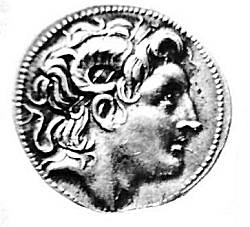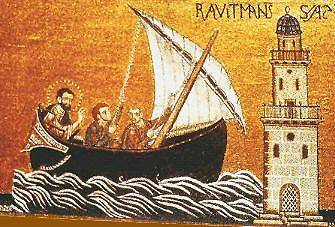Home
 The Arabs referred to Alexander as Eskander or Dzoul Karnein, the "Sire with the double horns" because of his portrait with ram horns on the Ptolemaic coins. The horns symbolized strength but also spiritual power. Often he was also called a Nabi; a Prophet: Nabi Eskender. And Alexandria was named and is still called Eskandereya.
The Arabs referred to Alexander as Eskander or Dzoul Karnein, the "Sire with the double horns" because of his portrait with ram horns on the Ptolemaic coins. The horns symbolized strength but also spiritual power. Often he was also called a Nabi; a Prophet: Nabi Eskender. And Alexandria was named and is still called Eskandereya.
Although one should be sceptical as to whether the Great Library of Alexandria was destroyed by Amr and of the manner in which it is described, it can be said with certainty that the destruction of what had been spared until then of the Great City followed the Arab conquest. The town totally lost its importance and the destruction was completed by the Turks at the beginning of the 15th century.
But Alexander and his tomb are remembered in the Arab tradition and are referred to by Macoudi35, who mentions a modest construction existing in Alexandria until 943-944 called the "Tomb of the Prophet and king Eskender".
Then it seems that we have a gap and we hear no more about Alexander's tomb for five centuries.
The destruction of Alexander's Mausoleum must not surprise us, as besides repeated disasters due to man, tremendous earthquakes, sometime with tidal waves, caused the subsidence of the geological plateau, which led to the poor state of preservation of all the ancient and early medieval town36. Another famous and enormous Alexandrian building, the Pharos has completely disappeared37. But while for the Pharos the location is known with certitude and some of its architectural remains can still be seen, the Soma seems to have totally vanished.

In the early part of the 16th century, Leo the African38 (1494-1552) sought for the vestiges of Alexander's tomb and was shown a small building venerated by the Mohammedans who deposited in it offerings.
The traveller Marmol39 in 1546 was also shown a small building venerated by the Arabs as the tomb of the Prophet Eskender in the center of the town among the ruins. Similar mention is made by the travellers Geo Sandys40 and Michael Radzivill Sierotka41, at the end of the XVI c. (1582-1584). J.J. Ampère says that the Arabs of Alexandria showed in the XV c. the tomb of the prophet Iskander42.
At that time the once great city, numbered probably only 6,00043 inhabitants. The natives had withdrawn from the Greco-Roman town to the site of the Heptastadion that connected the mainland to the island of Pharos and had been reclaimed over the centuries by the Nile's alluvium.
Photos: (top) Silver coin of Alexander wearing the horn of Ammon. Issued by his successor Lysimachus in 280BC and probably based on the idealised portraits in his lifetime by court gem-artist, Protogenes; (bottom) The Pharos.
Notes:
35. Macoudi: Les prairies d'or, transl. By O. Barbier de Meynard and Pavet de Courteille, t. II, p. 259.
36. Mieczyslaw Rodziewicz, "Graeco-Islamic Elements of Kom el Dikka in the light of the new discoveries; Remarks on early Mediaeval Alexandria, Graeco-Arabica, Vol. I, Athens (1982).
37. The Pharos had been partly preserved up to the medieval times as it was restored then transformed into a mosque, but was totally destroyed in 1303 during the tremendous earthquake.
38. Descrizione dell'Africa (for this work see R. Brown's exhaustive ed.of J. Powys's translation (1600), Description of Africa, 3 vols. (Hakluyt Soc., no 92-4, London, 1896).
39. Marmol, De l'Egypte III, p. 276, lib. XI, cap. 14.
40. Geo Sandys, Relation of a journey, cf. H. Tierch, "Die Alex. Konigsnecropole", JDI, XXV, (1910), pp. 53-92.
41. Hierosolymitana peregrinatio illustrissimi domini Nicolai Christopheri Radzivilli, … Ex idiomate Polonica in latinum linguam translate... Thorma trelere interprete, Brunsbergae, (1601) and Polish, Krakow, (1925), p.120.
42. J.J. Ampère Voyage en Egypte. Rev. des deux Mondes. (1846).
43. According to M.F. Awad the estimated population of Alexandria in 1806 was 6,000 inhabitants, in 1821 12,000 inhabitants, in 1835 52,000, in 1868 200,000; the census of 1897 listed 316,699 souls, of 1917 458,539, of 1947 949,446, rising to 1,516,234 in 1960 ROMM 46, (1987) 4.